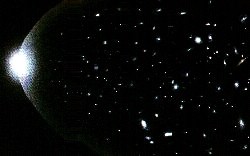

As far away as our largest telescopes can see into the universe, all the
galaxies of stars we can see appear to be moving apart from each other. This
implies that at some distant point in the past, they must have been much closer
together.
 Because light moves at a finite speed (300,000 km per second), and the universe is so vast, it takes light a long time to get here. Images of the nearest stars take years to get here. (If Alpha Centauri, the nearest star to the solar system, were to somehow disappear tomorrow, we wouldn't know about it for over 4 years. Or, saying the same thing a different way, the star we see in the sky is really the way that star looked over 4 years ago.) When we look at nearby galaxies, we are looking at them the way they appeared millions of years ago. When we look out at the furthest reaches of the universe, at the limit of what our largest telescopes can resolve, we see galaxies as they appeared up to 14 billion years ago. Since this is only a few billion years after the Big Bang, we are just about to the point where we can actually observe the birth of the universe! In fact, we can even detect the left-over energy from that explosion. |